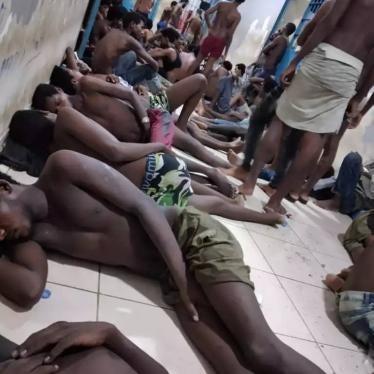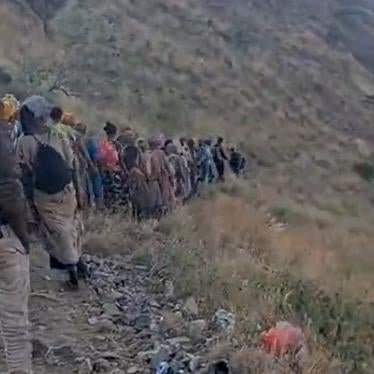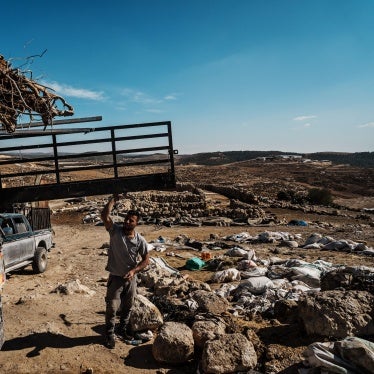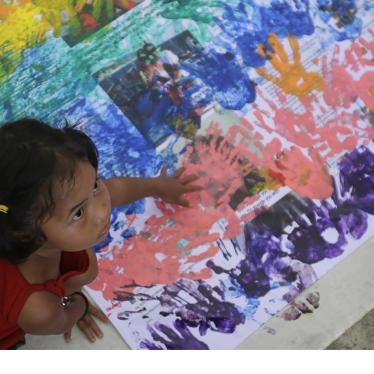*From the IDC report Covid-19 Impacts on Immigration Detention: Global Responses*
Saudi Arabia introduced measures to limit the spread of COVID-19 beginning in March 2020, including suspending religious pilgrimages and halting international and domestic travel. On March 30, King Salman announced that everyone in Saudi Arabia would be entitled to medical care for COVID-19 regardless of their legal status in the country.[1] Infections remained low throughout March but began to spike in April and May. Despite government efforts to limit the spread of the coronavirus, Saudi Arabia had nearly 330,000 confirmed infections and 4,485 deaths as of mid-September 2020.[2] The spike was seemingly driven by transmission among foreign migrant workers. In April, the Saudi Center for Disease Prevention and Control issued new guidelines to prohibit overcrowding in migrant housing.[3] On May 5, the health minister announced that non-Saudis made up 76 percent of new cases recorded in Saudi Arabia.[4] Saudi authorities released 250 immigration detainees in March but has not otherwise addressed the risks of locking large numbers of migrants in detention centers. The United Nations has called for alternatives to immigration detention during the pandemic,[5] given the increased risk of contracting the novel coronavirus in the crowded and unhygienic conditions in most detention sites. But in Saudi Arabia, the detention of migrants during the COVID-19 pandemic has continued. And while it is difficult to find out what is happening inside those centers, a recent Human Rights Watch report indicates that the precautions and treatment for COVID-19 are minimal.
Ethiopian Migrants in Saudi Arabia
An unpublished 2019 study[6] found that over 90 percent of the migrants passing through Yemen to reach Saudi Arabia and other Gulf countries for work opportunities come from Ethiopia. A combination of factors, including economic difficulties, drought, and human rights abuses have driven hundreds of thousands of Ethiopians to migrate over the past decade, most traveling irregularly by boat over the Red Sea and then by land through Yemen to Saudi Arabia. The International Organization for Migration (IOM) estimated that nearly 140,000 migrants arrived in Yemen in 2019. Migrants who cross irregularly into Saudi Arabia usually do so in the mountainous border area separating Yemen’s Saada governorate and Saudi Arabia’s Jizan province. Many are apprehended crossing the border or in the country’s interior. About 260,000 Ethiopians, an average of 10,000 per month, were deported from Saudi Arabia to Ethiopia between May 2017 and March 2019, according to IOM.[7]
The detention of migrants in deplorable facilities in Saudi Arabia is a longstanding problem. In 2014, Ethiopian nationals in the Saudi capital, Riyadh, told Human Rights Watch that thousands of foreign workers were being held in makeshift detention facilities without adequate food and shelter before being deported.[8] In 2019, Human Rights Watch identified approximately 10 prisons and detention centers where migrants were held for various periods.[9] While deportations from Saudi Arabia to Ethiopia have been ongoing during the pandemic, the sheer numbers of Ethiopian migrants across the world who want to return makes it very difficult for Ethiopia to receive and process its nationals in quarantine in the capital, Addis Ababa.[10]
Saudi Arabia's Detention of Ethiopian Migrants during the Pandemic
In April 2020, while most countries were in the middle of nationwide lockdowns, the Houthi armed group forcibly expelled thousands of Ethiopian migrants from northern Yemen using the COVID-19 pandemic as a pretext, forcing them to the Saudi border and killing dozens. Saudi border guards then fired on the fleeing migrants, killing dozens more, while hundreds of survivors escaped to a mountainous border area. Ethiopian migrants told Human Rights Watch that after they spent days stranded without food or water, Saudi officials allowed hundreds to enter the country. The Saudis then arbitrarily detained hundreds if not thousands of Ethiopian migrants for months in unsanitary and abusive facilities without the ability to legally challenge their detention or eventual deportation to Ethiopia.[11] The three prisons most often cited by detained Ethiopian migrants among the 10 detention centers that[12] Human Rights Watch identified in 2019 were Jizan Central Prison in Jizan city, the Shmeisi Detention Center east of Jeddah, where migrants are processed for deportation, and a center near the town of al-Dayer in Jizan province along the border.
Ethiopian migrants described being taken in small cars and pickup trucks from the Saudi border to a detention facility in al-Dayer. Human Rights Watch has identified through open source technology a prison complex in al-Dayer that matched the descriptions of those interviewed. Human Rights Watch spoke to women and girls who estimated that 300 to 500 of them were held in one room in severely overcrowded conditions after they were separated from the men. Human Rights Watch reviewed video footage sent by a person held in al-Dayer that depicts hundreds of women under a wire mesh roof, ankle deep in filthy water, screaming and crying. Women and girls said their situation generally improved when they were taken to a detention facility in Jizan. Human Rights Watch analyzed satellite imagery together with witness accounts and found a complex in Jizan city. For men, the conditions deteriorated when they got to Jizan.
Both men and women consistently described poor detention conditions including overcrowding, blocked, inadequate, and overflowing toilets, lack of beds and blankets, lack of medical care including prenatal care for those who were pregnant, and inadequate food and water. They described serious skin problems they said were caused by the unhygienic conditions. Photo images and videos of detainees in al-Dayer and a detention center in Jizan corroborated the accounts. Men described sleeping in the same clothes they had worn since they arrived with limited access to water to wash and no medical care. They said that their temperatures were taken when they entered Jizan, but that they have had no other COVID-19-related testing, prevention measures or guidance, or care. Three men said that prison guards beat them for asking for medical attention or complaining about the conditions. Given the lack of COVID-19 testing, Human Rights Watch was not able to verify if any of the Ethiopian migrants in detention contracted the novel coronavirus. Human Rights Watch spoke to six women who had been transferred from Jizan to the Shmeisi Detention Center, near Jeddah, where conditions were described as better but still inadequate and from which some of the female interviewees were returned to Ethiopia. IOM’s office in Ethiopia registers migrants upon arrival in Ethiopia from Saudi Arabia. On June 9[13] the organization had registered 3,000 Ethiopian returnees from Saudi Arabia since April. Based on migrant accounts gathered since the release of the statement in August, Human Rights Watch estimates that there are hundreds, perhaps thousands, of Ethiopian migrants pushed out of Yemen in April who remain in deplorable detention conditions in Saudi Arabia.
Recommendations
The Saudi government should investigate and appropriately discipline or prosecute security personnel responsible for firing upon Ethiopian migrants at the Yemen border. Any “shoot on sight” order should be immediately revoked. The authorities should also investigate allegations of abuse at migrant detention centers, and appropriately discipline or prosecute those found responsible. Immigration detention should be an exceptional measure of last resort, for the shortest period, and only if justified by a legitimate purpose. Children should never be detained for migration related reasons. In the interim, Saudi authorities should transfer migrant detainees to centers that meet international standards and should work with international agencies to bring migrant detention centers in line with international standards under the UN Standard Minimum Rules for the Treatment of Prisoners (“Mandela Rules”). The Saudi authorities should urgently identify and release children along with their family members, and provide safe alternatives to detention to which humanitarian agencies have regular access. They should also identify and release pregnant and nursing women in line with international guidelines on the detention of asylum seekers. Those released from detention facilities should undergo adequate medical screening to ensure they receive, if necessary, proper care and follow-up. Beyond the immediate crisis of Ethiopian migrants in detention, Saudi Arabia should ratify the 1951 Refugee Convention and establish asylum procedures consistent with international standards for stateless people and foreign nationals at risk of persecution in their home countries. Saudi Arabia should immediately allow the UN High Commissioner for Refugees to exercise its mandate by allowing it to determine asylum seekers’ refugee status and facilitate durable solutions, including integration in Saudi Arabia, for those recognized as refugees.
[1] https://english.alarabiya.net/en/News/gulf/2020/03/30/Coronavirus-Saudi-s-King-Salman-orders-treatment-for-all-including-visa-violators.html
[5] https://migrationnetwork.un.org/sites/default/files/docs/un_network_on_migration_wg_atd_policy_brief_covid-19_and_immigration_detention_0.pdf
[6] https://reliefweb.int/report/yemen/journey-africa-yemen-remains-world-s-busiest-maritime-migration-route
[8] https://www.hrw.org/report/2014/05/25/yemens-torture-camps/abuse-migrants-human-traffickers-climate-impunity#_ftn187








